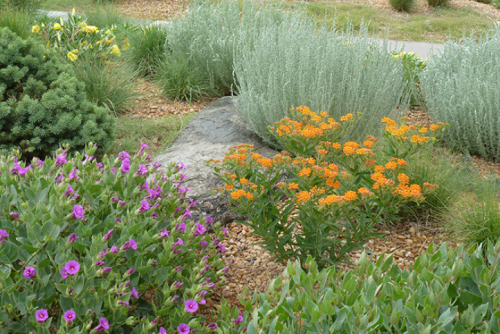
Back to the roots: Making a difference from your yard
Replacing our yards with native plants has an array of proven benefits for the environment and our wallets.
“A fine lawn makes a frame for a dwelling.”
This seemingly quaint statement, made by real estate developer Abraham Levitt in 1949, ultimately explains how the idea of the “American lawn” came to be. Levitt is credited with revolutionizing the American housing system, popularizing the famous cookie-cutter suburban framework that is so prevalent today. When most of us think about a front lawn, what comes to mind is often a monochromatic, bright green array of grass that is uniformly trimmed to a nice and neat level.
A symbol of the American desire to control nature, this ideal American lawn is found represented throughout all 50 U.S. states. However, what most do not consider is that this one-size-fits-all conceptualization of how our lawns should be disregards the massively diverse ecological histories of our environments and also ends up taking money out of your pockets.
In Colorado, when you see a typical vibrant green lawn, what you are likely seeing is Poa pratensis, commonly known as Kentucky bluegrass due to its prevalence in Kentucky. This name is a misnomer, as this species of grass is not native to Kentucky, nor Colorado, or anywhere in the entire United States. Native to Europe, northern Asia, and parts of northern Africa and popularized in America because of its color and texture, “Kentucky bluegrass” has come to dominate our lawns.
However, the desire for the perfect lawn comes with an ecological cost. As this type of grass is not adapted to the environments that we plant it in, it requires vast amounts of water and intervention to establish and grow. According to a 2019 estimation, those in the Denver area alone were using 120 million gallons of water per day watering their lawns, accounting for 50 percent of total single-family home water usage. Ecologically, cultivating non-native grasses in our lawns is like trying to fit a square peg in a round hole.
While our lawns currently take a heavy toll on the environment — and our wallets — there is an alternative solution that can be adopted throughout all of America; rethinking the ideal lawn and choosing to plant native species of grasses and other plants. Moving away from unsustainable lawn practices can have cascading impacts.
These native species are well adapted to local conditions, meaning that they require much less maintenance and intervention to grow. In Colorado, our native grasses are drought-resistant and have adapted to be able to withstand conditions of high heat and low rainfall. The cultivation of these native grasses, rather than the thirsty Kentucky bluegrass, would have significant impacts on sustaining a dwindling water supply.
Past saving water, native lawns also promote biodiversity and wildlife, increasing ecosystem health as a whole beyond the yard. In ecosystems, species develop alongside one another utilizing countless complex interactions to flourish as a whole system.
Planting native species can provide a habitat for native species such as bees, birds, butterflies, and countless other critters which have long been pushed out of our yards by unsustainable, destructive practices. When you choose native species, you are doing your part to restore habitats and cultivate a better relationship with nature.
By choosing to plant native species, we can foster a deeper meaning of what it means to be a Coloradan. Rick Schultz, Water Efficiency Supervisor for Castle Rock, CO, and advocate for native gardening, coined the term “Colorado-scaping.” In his view, planting native species promotes a landscape that ‘fits the look and feel of Colorado’s Front Range.’
When you look outside your window and see the flora that has populated Colorado for thousands of years, one may simply feel a deeper connection with the land they live on rather than if they were looking at rows of neatly mowed non-native grass. Through native gardening, we can foster an appreciation and a relationship between ourselves and the environment.
It is time to shift away from our outdated perceptions of what lawns should look like. Why should we continue to cling to the ideal American lawn, rooted in unsustainable practices and a worldview of human dominion over the environment?
With the vastly diverse ecological beauty of America, choosing to continue to strive for plain green lawns that degrade the environment is simply irresponsible. Luckily, native gardening is becoming increasingly accessible in Colorado. For us in Boulder, the City of Boulder offers a concise guide with valuable resources to learn about things such as the benefits of native gardening, what to look out for, what plants are native to Boulder, and much more as well as more descriptive, comprehensive guides for those with more experience gardening.
Due to the massive scale of production of more popular types of grasses and plants, these plants are often the cheapest options (the highest rated Kentucky bluegrass seeds on Amazon come in at $0.60 per ounce, while a mixture of Colorado native grasses can be found on Amazon for $1.75 per ounce). However, when factoring in reduced maintenance costs and reduction in water usage, native gardening can end up costing you less than having a traditional American lawn.
Local establishments such as Harlequin’s Gardens have made native species easy to learn about and buy. We hear so much about the harm we are doing to the world, and native gardening offers a way to change the world from our own lawns.


Great article. We need more of this.